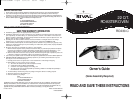
COOKING GUIDE
-E6-
-E7-
DETERMINING MEAT DONENESS
It is recommended that you use a meat thermometer to determine doneness
when cooking meat and poultry. Insert the thermometer into the center of
the thickest portion of the meat. Cook until temperature for desired doneness
is reached.
*Rare pork, ham or poultry is not recommended.
BEEF
PORK
LAMB
SMOKED HAM
Cook before eating
Fully cooked
POULTRY
Roasting Chicken
Turkey
140° F
*
140° F
*
*
160° F
160° F
160° F
170° F
170° F
170° F
160° F
140° F
180° F
180° F
MEAT RARE MEDIUM WELL DONE
BEEF ROASTS
Standing Rib 4 – 6 325° F 17 to 21
Sirloin Tip 3 – 5 350° F 17 to 21
Tenderloin 3
1
⁄2 – 4 450° F 7 to 10
Pot Roast 4 – 6 300° F 26 to 34
Corned Beef 3
1
⁄2 – 4 300° F 15 to 17
LAMB
Leg 5 – 8 350° F 20 to 22
Shoulder, boneless 3 – 4 350° F 20 to 22
PORK
Loin Roast 3 – 5 350° F 21 to 26
Rolled Shoulder 4 – 6 350° F 30 to 34
Chops 4 – 5 325° F 15 to 17
Country-Style Ribs 8 – 10 450° F to brown and…
…then decrease temp. to 250° F 15 to 17
SMOKED HAM
Bone-in, shank 10 – 15 325° F 17 to 21
Boneless 8 – 12 325° F 15 to 17
Fully cooked 5 – 10 325° F 13 to 24
VEAL
Loin 4 – 6 325° F 26 to 30
Shoulder 3 – 5 325° F 26 to 30
POULTRY
Chicken, whole 3
1
⁄
2 – 5 350° F 13 to 15
Chicken, whole 6 – 8 350° F 15 to 17
Chicken, pieces 6 – 8 350° F 7 to 9
Turkey, prebasted 10 – 14 375° F 12 to 15
Turkey, prebasted 14 – 22 375° F 13 to 15
Turkey, fresh 10 – 14 350° F 15 to 17
MEAT WEIGHT (LBS.) TEMP. MIN./LB.
ROASTING MEATS AND POULTRY
Meats will cook more rapidly in the Roaster Oven than a conventional oven.
Reducing temperature and increasing time will result in a browner, crispier
crust. Times indicated below are approximate and should be used as a
guideline only.
RO230C05ESM1 V.qxd 6/11/05 09:41 Page 7














